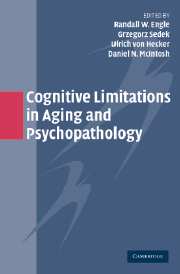Book contents
- Frontmatter
- Contents
- List of Contributors
- Preface
- Acknowledgments
- 1 Cognitive Limitations in Aging and Psychopathology: An Introduction and a Brief Tutorial to Research Methods
- SECTION I WORKING MEMORY AND COGNITIVE FUNCTIONS
- SECTION II AGING AND PSYCHOPATHOLOGY OF COGNITIVE CONTROL
- SECTION III ATTENTION, INHIBITION, AND REASONING PROCESSES
- 10 The Nature of Attentional Bias in Human Anxiety
- 11 Inhibition, Rumination, and Mood Regulation in Depression
- 12 Aging and Inhibitory Processes in Memory, Attentional, and Motor Tasks
- 13 Impairments of Memory and Reasoning in Patients with Neuropsychiatric Illness: Disruptions of Dynamic Cognitive Binding?
- 14 Generative Reasoning as Influenced by Depression, Aging, Stereotype Threat, and Prejudice
- Name Index
- Subject Index
- References
10 - The Nature of Attentional Bias in Human Anxiety
Published online by Cambridge University Press: 20 May 2010
- Frontmatter
- Contents
- List of Contributors
- Preface
- Acknowledgments
- 1 Cognitive Limitations in Aging and Psychopathology: An Introduction and a Brief Tutorial to Research Methods
- SECTION I WORKING MEMORY AND COGNITIVE FUNCTIONS
- SECTION II AGING AND PSYCHOPATHOLOGY OF COGNITIVE CONTROL
- SECTION III ATTENTION, INHIBITION, AND REASONING PROCESSES
- 10 The Nature of Attentional Bias in Human Anxiety
- 11 Inhibition, Rumination, and Mood Regulation in Depression
- 12 Aging and Inhibitory Processes in Memory, Attentional, and Motor Tasks
- 13 Impairments of Memory and Reasoning in Patients with Neuropsychiatric Illness: Disruptions of Dynamic Cognitive Binding?
- 14 Generative Reasoning as Influenced by Depression, Aging, Stereotype Threat, and Prejudice
- Name Index
- Subject Index
- References
Summary
The nature of the world in which mammals have evolved has resulted in an attentional system that is highly selective. It is obvious that natural environments consist of multiple objects, most of which also contain many different attributes. For example, a walk down a typical high street bombards us with a variety of sounds, colours, and odours. In addition to these external objects, there may also be a range of competing internal thoughts that occupy our minds. Because of this huge variety of stimuli, it seems clear that the ability to efficiently select and focus on currently relevant information is critical for coherent behaviour. In addition, it would also seem to be adaptive to rapidly notice stimuli that may pose a danger. For instance, it is important to notice the predator or potential mugger lurking in the nearby bushes. Therefore, in addition to the necessity for selection of relevant objects and thoughts, an efficient attentional system must also be open and flexible to stimuli that may represent a threat. Thus, there may well be a subset of stimuli that has privileged access to the attentional system. In addition to certain classes of stimuli that may be especially salient in terms of attracting attentional resources (e.g., snakes, spiders, angry facial expressions, etc.), there may be groups of individuals who are particularly sensitive to threat-related stimuli. Indeed, anxiety has often been characterized as the quintessential example of a hypervigilant attentional system.
- Type
- Chapter
- Information
- Cognitive Limitations in Aging and Psychopathology , pp. 249 - 274Publisher: Cambridge University PressPrint publication year: 2005
References
- 4
- Cited by

